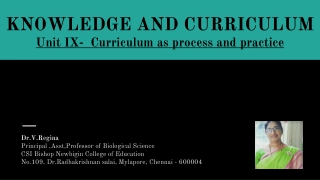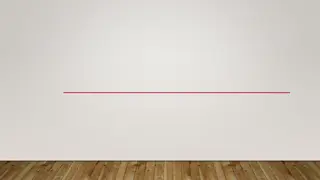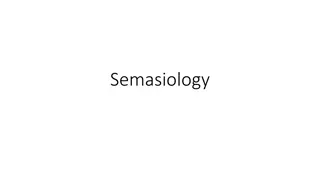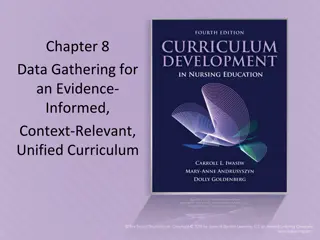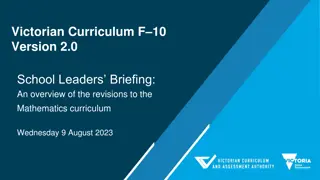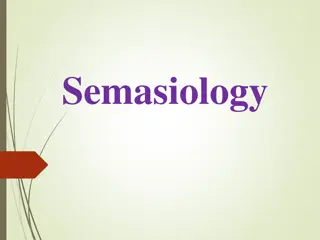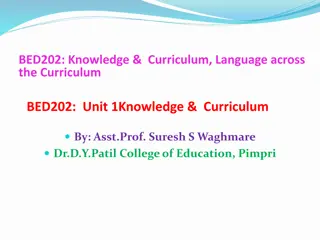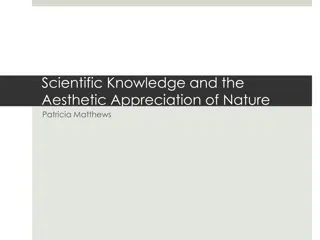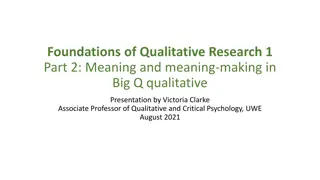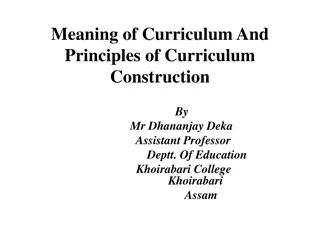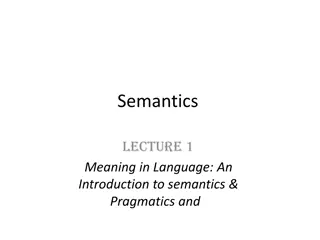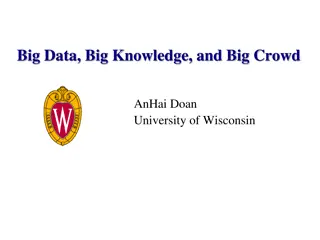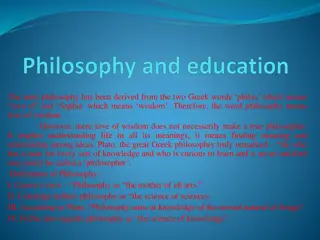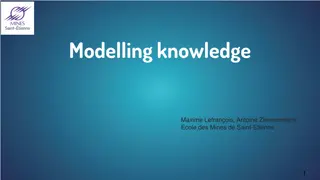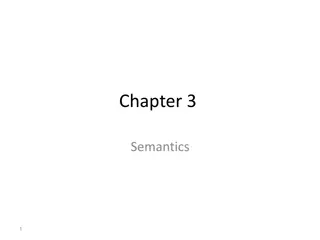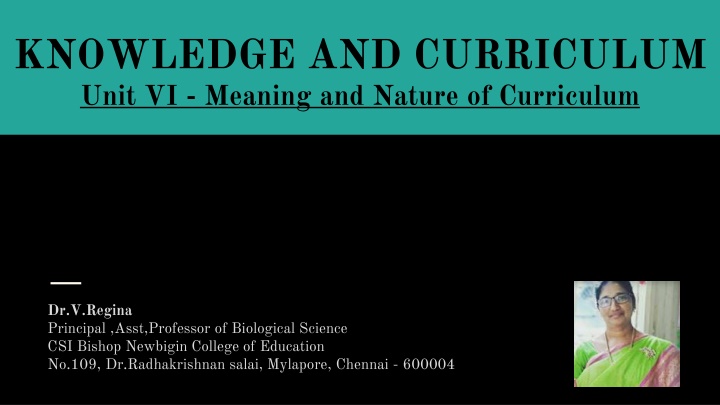
Meaning and Nature of Curriculum in Education
Explore the dynamic nature and various dimensions of curriculum as a tool for achieving educational goals and holistic student development. Understand the explicit and implicit aspects, societal influences, and design principles in curriculum development.
Download Presentation

Please find below an Image/Link to download the presentation.
The content on the website is provided AS IS for your information and personal use only. It may not be sold, licensed, or shared on other websites without obtaining consent from the author. If you encounter any issues during the download, it is possible that the publisher has removed the file from their server.
You are allowed to download the files provided on this website for personal or commercial use, subject to the condition that they are used lawfully. All files are the property of their respective owners.
The content on the website is provided AS IS for your information and personal use only. It may not be sold, licensed, or shared on other websites without obtaining consent from the author.
E N D
Presentation Transcript
KNOWLEDGE AND CURRICULUM Unit VI - Meaning and Nature of Curriculum Dr.V.Regina Principal ,Asst,Professor of Biological Science CSI Bishop Newbigin College of Education No.109, Dr.Radhakrishnan salai, Mylapore, Chennai - 600004
Definition Synopsis Dynamics of curriculum Meaning of Curriculum The explicit Intended curriculum Concepts of curriculum The implicit Formal curriculum Curriculum as the Education Program The null Taught curriculum - Program of Studies - Albert Oliver The extra Hidden curriculum - Program of Activities - Philip Phenix The rhetorical Received curriculum - Program of Guidance ( Hilda Taba) The societal Learned curriculum Curriculum as the scheme of values The concomitant Open curriculum - physical - intellectual - moral The phantom Actual curriculum - aesthetic - religious - cultural The phantom Visible curriculum Curriculum as the Function of Public school The open-system approach Tool - Preservation and transmission Changing concepts of curriculum as 4 categories Instrument - Transforming development Curriculum as plan Means - Individual Development Curriculum as an experience Structure of the curriculum Curriculum as a subject matter Curriculum Domains Curriculum as an objective Subject Matter Conclusion Curriculum Design Evaluative Procedures Dr. V. Regina , Principal CSI BISHOP NEWBIGIN COLLEGE OF EDUCATION
To achieve the pupils goals of life To achieve the pupils ideas of life Learning Objectives To achieve the pupils aspirations of life To help the pupils physical ,mental, social, moral, religious and aesthetic development To determine the needs of the pupil Aware of the skills,abilities,knowledge and values. Gains understanding and acceptance of diverse culture and Learning Outcomes ethnicities Enriches curriculum is to involve students in real life problem solving scenarios Dr. V. Regina , Principal CSI BISHOP NEWBIGIN COLLEGE OF EDUCATION
Definition The term curriculum is a latin word currere which means The term curriculum was first used in Scotland as early as running race or runway, which one takes to reach the goal. 1820 and became part of education. John Dewey(1902): 2010 Indiana Dept.of.Education : Curriculum is a continuous moving from the child s present Curriculum means the planned interaction of pupils with the experience out into that presented by the organized bodies of truth instructional content, materials, resources and processes for that we call studies are themselves experience - they are that of evaluating the attainment of the educational objectives. the race. Cunningham: Franklin Bobbit(1918): Curriculum is a tool in the hands of artist (teachers) to mould his Curriculum is the entire range of experience both directed and material (pupil) according to his ideal (objectives) in this studio undirected, concerned in unfolding the abilities of the individual. (school). Dr. V. Regina , Principal CSI BISHOP NEWBIGIN COLLEGE OF EDUCATION
Accordingly, a curriculum is the instructional and the educative programme by following which the pupils achieve their goals, ideals and aspirations of life. It is curriculum through which the general aims of a school education receive concrete expression. Traditional concept and the traditional curriculum was Meaning of curriculum subject centered while the modern curriculum is child and life- centered. It is the planned interaction of pupils with instructional content, materials, resources, and processes for evaluating the attainment of educational objectives Simply- A course of study. Dr. V. Regina , Principal CSI BISHOP NEWBIGIN COLLEGE OF EDUCATION
Concepts of curriculum Goals and purposes of education The concept if curriculum is dynamic as the changes that occur is society. Three facets of curriculum In its narrow sense, curriculum is viewed merely as a listing of subject to be taught in school. Evaluation of products Process of curriculum In a broader sense, it refers to the total learning experiences of individuals not only in school but in society as well (purital.Bilbo.Ed.D) The basis for any major curriculum change is significantly to improve the existing curriculum. Concept is considered as a blueprint of an educational programme. Dr. V. Regina , Principal CSI BISHOP NEWBIGIN COLLEGE OF EDUCATION
Curriculum as the Educational program According to albert olives The educational program with the basic elements: 1. The program of studies 1. The educational purpose of the program Listing of the subjects for each class or grade transmit. Culture is basic function- constructor must be able to think beyond this programme studies 1. The content teaching procedures and learning experience which will be necessary to achieve 1. The program of experience this purpose (the means). The program of experiences represented by activities in addition to the culture experience represented by studies. 1. Some means for assessing whether or not the 1. The program of services educational ends have been achieved. The program of services or guidance helps to solve the individual learners problem or job placement 1. Hidden curriculum Improve learning. Dr. V. Regina , Principal CSI BISHOP NEWBIGIN COLLEGE OF EDUCATION
Curriculum as scheme of values The 4th education should meet the need of individual in The 1st education should meet the basic need of man to be the society. The student : The teacher ratio tutorial system human. The physical skills, basic social skills, the ability testing. to use symbols (languages) play and moral responsibility. The 5th education should meet the needs of ideal The 2nd education should meet the actual need of the individuals - physical, intellectual, moral, aesthetic and society. The occupation, social condition, livelihood, religions. defense, religion etc The 6th education should meet the community s identity The 3th education should meet the needs of present society or well-being - value system - a total life. and the future ideal society - social order and work. Dr. V. Regina , Principal CSI BISHOP NEWBIGIN COLLEGE OF EDUCATION
Curriculum as the function of public school It should uphold the ideals of individual development. Complex task Basic education - comprises of intellectual development The schools have the responsibility of inducting the young as the distinctive function - assertion - intellectual training. into the culture in which the school exists. These three functions of public schools help to decide Education must be an agent of change - that why the curriculum practices such as contemporary problems changes in the existing culture. rather than ancient history. Dr. V. Regina , Principal CSI BISHOP NEWBIGIN COLLEGE OF EDUCATION
Structure of the curriculum 3. Curriculum Design: The structure of the curriculum comprises 4 sets of components :- - Drawing up curriculum proposals 1. Curriculum domain: - Learning experiences ( cognitive, affective and conative) - Subject design : humanities/science and social science - Intellectual development : persistent human relations - Value development : skills - Skill development : classroom / school/ community - Long term goal - goal - Desired learning outcome - objective 4. Evaluative Process: 1. Subject content/ Curriculum content: - Formative - adjustment, improvement thought our planning. - FACTS - Observation - Summative - end, feedback, repeat modify, eliminate the - CONCEPTS - factual data plan. - RULES Two or More Concepts - GENERALIZATIONS Dr. V. Regina , Principal CSI BISHOP NEWBIGIN COLLEGE OF EDUCATION
Dynamics of Curriculum The hidden/ covert curriculum: Nature of schools, daily routines, learning from the nature or organisation design, behaviour, attitudes. Changing the courses and subjects according to current trends. Movement and change in curriculum according to the needs of Phantom Curriculum: Exposure to any type of media. the society. Concomitant Curriculum: Religious values, ethics, morals, molded Explicit curriculum: Refers to the plan for learning set by a behaviour. teacher or school board, text books, films and web sources. Rhetorical Curriculum: Ideas by policy makers, officials, come Null Curriculum: Refers to the lesson that students take from through the published works offering updates in pedagogical teachers attitude and the school environment or hidden curriculum. knowledge. Written curriculum(Overt or explicit): curriculum documents/ Curriculum in use: Written overt in use films / textbooks reviewed by administrators curriculum. Received curriculum : Actual take out of classroom The internal curriculum: unique to each students Societal Curriculum (social curriculum): Massive, ongoing The electronice curriculum: E-forms of communication. informal curriculum of family, peer group, neighbourhoods, churches,organisations, occupations, mass media etc. Dr. V. Regina , Principal CSI BISHOP NEWBIGIN COLLEGE OF EDUCATION
The open systems approach and the para curriculum School environment: - Size of the community - Level of parent s activity - Background of the students Formal aspect Para curriculum - Support services of the school Informal aspect - Financial support Climate of the school Formal aspect - Political and other pressure Atmosphere of the sschol Open curriculum: Null curriculum - Student s motivation Extra curricular - curriculum - Student s aspiration Rhetorical curriculum - Student s achievement. Concomitant curriculum - Religious / Values Phantom curriculum - Media Dr. V. Regina , Principal CSI BISHOP NEWBIGIN COLLEGE OF EDUCATION
Changing concepts of curriculum It comprises 4 categories :- 3. Curriculum as a Experience: - Carter V. Good - Educative Experiences 1. Curriculum as a plan: - Tanner and tanner - Reconstruction of knowledge - Plan for all experiences - Secondary Education Commision - Totality of Experience - Plan for specific materials - Crow and crow - Learner experiences - Tyler and hilda taba - As a plan for action - Anderson - School and pupils Experience - Galen saylor-As a plan for Providing sets of learning opportunities - John Dewey - Learners experience - David pratt- As a plan training intentions - Wiles and bondi- curriculum as a plan for learning 4. Curriculum as an Objective: - B. F. Skinner. Activities - Based Objectives 1. Curriculum as a subject matter: - W.w. Chatters. Series of Objective - Doll - formal and informal content - Posner -Instruction objectives - Encyclopedia - formal syllabus - course of study - Hilda Taba- Learning and Teaching Objectives - Subject - age group - Method of teaching - planned Dr. V. Regina , Principal CSI BISHOP NEWBIGIN COLLEGE OF EDUCATION
The curriculum content should be functional, aiming at promotion the all-round development of present student and helping them to lead an independent life and integrate into the community. Curriculum as a body of knowledge to be transmitted Conclusion Curriculum as an attempt to achieve certain ends in students- product. Curriculum as process Curriculum as praxis. Dr. V. Regina , Principal CSI BISHOP NEWBIGIN COLLEGE OF EDUCATION
Suggestive Readings Evaluating the curriculum - Book. - J. Bradshaw and A. Hammick. GFC www.google.com SaylorG and Alexander, M planning curriculum for schools,Holt. Rinchart and Winston . Inc> NewPork. beethovens_silence.mp3 Dr. V. Regina , Principal CSI BISHOP NEWBIGIN COLLEGE OF EDUCATION

